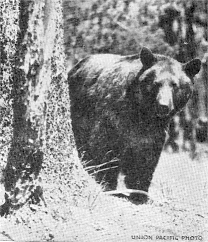
| Online Library: | Title | Author | California | Geology | History | Indians | Muir | Mountaineering | Nature | Management |
Yosemite > Library > Bears > Sierra Nevada Black Bear (Ursus americanus californiensus J. Miller) >
Next: Bear Policy • Contents • Previous: California Grizzly
The bears now found in Yosemite National Park are a subspecies of the American Black Bear, which ranges in forested areas from the Atlantic to the Pacific, and from northern Canada southward into Sonora, Mexico.
The black bear has several color phases, ranging from coal black to light brown or cinnamon. This has led to the erroneous belief that the various color phases represent different species. Black phase females often produce brown cubs, or one black and one brown cub, and brown colored females do likewise. In Yosemite, the brown color phase seemingly predominates, as borne out by an accurate check of the bear population in the vicinity of Glacier Point during the summer of 1939.

|
A similar count made by Joseph Dixon, Field Naturalist, Fish and Wildlife Service, in Yosemite Valley on October 30, 1929, at the old feeding pits, showed that out of a total of twenty-one, 17 were brown and only 4 black (Fur-bearing Mammals of California, p. 103).
The black bear normally ranges in the Transition and Canadian life zones in Yosemite, which includes elevations from 3,000 to 8,000 feet. Occasional records as low at 2,000 feet and as high as 9,000 feet have been made within the park, but these are probably extremes.
The density of the bear population in the park varies widely from place to place. Total estimates for the entire 1,189 square miles embracing Yosemite National Park vary between 300 and 400 bears. These figures have been determined by an annual wildlife census taken by patrolling rangers throughout the park.
During the past ten years the heaviest bear concentration has been in Yosemite Valley. This was mainly the result of “bear show” feeding, which was discontinued in 1940. Before that year, it was not unusual for 40 or more bears to put in appearance at the feeding area to enjoy their garbage “banquet.” It would be safe to say that between 1930-1940, as many as 60 bears summered in Yosemite Valley, where under primitive conditions, the area would hardly be large enough to support over three or four individuals.
Little is known about the length of life of black bears in the wild, due to the habit of sick or injured bears crawling away to some secluded spot where their carcasses are seldom found by humans. In captivity, bears often live 25 years or more, but in the wild they would probably average much less-possibly between 15 and 20 years. According to old time rangers, individual bears in Yosemite are known to have appeared for 15 successive years, so the ages mentioned are not far amiss.
A bear is considered mature at the age of 3 or 4 years, when most females have their first young. Full growth is not attained, however, until the sixth or seventh year, when they gain their greatest weight. According to Dixon “an average adult black bear in good flesh will, we have concluded, weigh between 200 and 300 pounds. Large-sized male bears may weigh as much as 500 pounds when fat (Fur-bearing Mammals of California, p. 101).
The writer has had several opportunities since the publication of the above book to assist in weighing trapped “garbage fed” bears in Yosemite that greatly exceeded the 500 pound maximum recorded by Dixon. The trapping alive of park bears is sometimes resorted to in the public campgrounds and other areas where bears are prone to raid food supplies. This is accomplished in a humane manner through the use of a large, galvanized iron cylinder mounted on trailer wheels. The cylinder is equipped with a trap door on one end, and the bear is enticed into the trap by a meat bait. Touching the bait causes the trap door to drop and the bear becomes a prisoner. The trailer can then be coupled to a government car, and transported to a more remote spot where the bear is released.
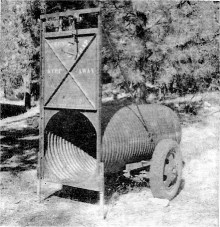
|
On September 28, 1938, a large male bear (brown color phase) was captured in the above manner. Due to his large size, it was considered worthwhile to secure an accurate record of his weight before release. The trailer containing the bear was backed onto the government platform scales by Wildlife Ranger Otto Brown. The results were so astounding that the writer was called in to verify the findings. After properly balancing the scales, the combined weight of the trailer and bear was 1,670 pounds. After releasing the bear, the empty trailer alone weighed 990 pounds. The bear was thus found to weigh 680 pounds which, according to all available data, is a record for the California Black Bear and subspecies. This unusual weight record can be attributed in part to the artificial feeding of bears carried on between 1930 and 1940, and is undoubtedly more than could be expected for bears eating natural food only (Yosemite Nature Notes, November 1938).
The expression “as hungry as a bear” is particularly true in late summer and fall when bears eat, not only to take care of their immediate daily needs, but to build up heavy layers of fat necessary to carry them through their winter “sleep.” With the coming of the first heavy storm of winter (usually in December or early January) most bears go into hibernation. The den is usually a warm and sheltered cave among the rocks, or a hollow tree, fairly high on the talus slopes surrounding Yosemite Valley or above the rim. Here they remain until late March or early April, depending on the severity of the winter. They hibernate singly except where cubs may occupy the den with the mother the winter following their birth.
As a rule, bears partake of no food or water during the hibernation period, depending on the breaking down of the fatty tissues built up during the previous fall to sustain life; however, they have occasionally been observed outside their dens during mild winters. From a study of the tracks of such individuals, it appeared that they were out simply for exercise between storms. By following their tracks it was possible to locate a number of bear dens which otherwise would never have been found without the use of dogs.
During January 1932, bear tracks were reported by local skiers on the slopes of Mt. Watkins at elevations between 7000 and 8000 feet. On March 3, former Park Naturalist Bert Harwell and Park Photographer Ralph Anderson succeeded in locating one of the dens, and obtained proof that it was occupied by a hibernating bear.
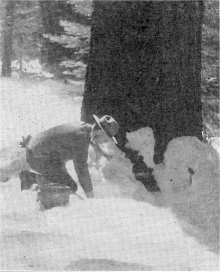
Bear Den on Mt. Watkins |
The den was located in a living White Fir, 5 ft. in diameter, and was reached through a vertical hole in the 4 feet deep snow, at the bottom of which was a horizontal tunnel about 18 inches in diameter which ran into the opening at the tree base. After setting up both still and
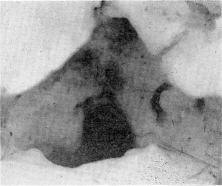
Close-up of Den |
Picture taking was forgotten and all haste was made to get Ralph to the hospital for proper treatment. The scar on Ralph’s hand even after ten years gives positive evidence that the den was truly occupied by a hibernating bear. It is also another indication that bears at this latitude do not enter a state of coma but on the contrary may sleep rather lightly (Yosemite Nature Notes, April 1933).
It has been generally supposed that the habit of hibernation in black bears was to enable them to escape the cold weather of the winter months. Observations in Yosemite would indicate, however, that the availability of food during this period is the chief controlling factor. This was well illustrated during the winter of 1936-1937, when at least a half dozen bears were observed on the valley floor all winter. They were seen most often around the incinerator where scraps of food could be had. The first snow storm of the season on the valley floor occurred December 26. That month 53 inches of snow fell; January added 78 1/2 inches; February 9 1/2 inches, and March 10 1/2 inches, making a total of 151 1/2 inches of snow for the floor of the valley. This was an unusually heavy precipitation. Coupled with this, temperatures reached to the lowest level ever recorded for the valley.
On February 18, 1937, Bert Harwell, then park naturalist, and I found a fresh set of tracks leading up Indian Canyon which we followed in hopes of finding a den. We soon found many other tracks and evidence of bear activity recorded on both snow and trees. Some 400 feet above the valley our set of tracks disappeared into a hole among the rocks, and freshly cut twigs of mistletoe were everywhere abundant.
Being the junior member of the
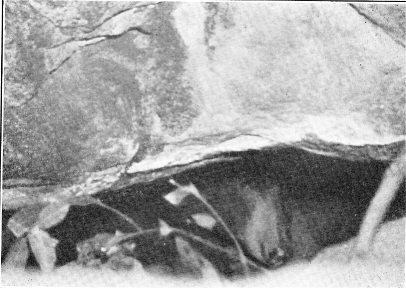
Bear Photographed in Den—Indian Canyon |
Although breeding data for the black bears in Yosemite are few, it is believed that late June is the time when most of them mate. With a gestation period of approximately 71/2 months, this means that cubs are, for the most part, born around the latter part of January, or early February, while the mother is in hibernation.
Cubs are generally born in pairs, although triplets or even solitary
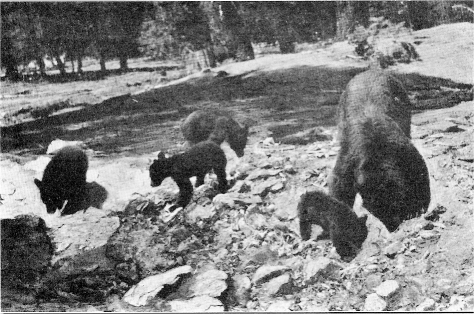
The Glacier Point Quadruplets |
Cubs at birth are extremely tiny, probably weighing less than a pound each. Their growth and development are at first unusually slow. In one case where a cub was born to a mother in captivity, it was 39 days before the cub opened its eyes (Fur-bearing Mammals of California, p. 125). The nursing period lasts for about six months, but the cubs will travel with the mother their first year, usually hibernating the next winter in the same den with the mother, or in a den nearby.
In Yosemite, new born cubs seldom emerge from the den with their mothers until late April, and are rarely observed on the valley floor before May or June. At this time they are about 14 inches long, stand a foot high, and weigh in the neighborhood of 10 or 12 pounds. They soon learn to supplement their milk diet with other food, and put on weight rapidly. On November 20, 1935, we had an opportunity to weigh a pair of cubs who were approximately 10 months old, and found the female to weigh 80 pounds and the male 120 pounds. No explanation accounting for the difference in weight can be advanced except the difference in sex (Yosemite Nature Notes, April 1936).
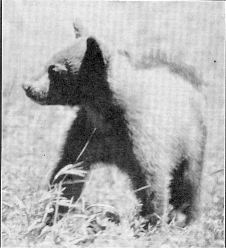
Cub at Six Months |
The mother bear is usually quite solicitous about the well being of her cubs, fondling and playing with them, and protecting them when in danger. They very soon learn to scramble up the nearest tree at the first warning sound from the mother. A mother has been observed spanking and soundly cuffing her cubs because they did not go up a tree quickly enough after she had given them a warning of danger.
In spite of maternal care, however, as the cubs grow in size they usually dwindle in number. Sickness and accidents take their toll, although the death rate is surprisingly low considering the number of rapidly moving automobiles they have to dodge. The male bear would try to kill or injure any cub that comes within his reach, including his own offspring. One cub was sideswiped by a male’s paw as it was belatedly trying to scramble up a tree trunk to safety, and suffered an injured hip as a result. It was possibly this same cub that later furnished an interesting incident for a group of people assembled around a mother bear and her three cubs on July 4, 1933, in the lower end of Yosemite Valley.
The mother bear did not seem to mind the attention of the crowd other than to show her disapproval by growling and smacking her lips when various individuals came too close in order to get pictures. She finally got the cubs away from the crowd by wading out into the Merced River where she sat down with the water up to her neck, and proceeded to give the cubs a bath. When this was over, they returned to the bank to be further annoyed by the interested spectators. At last in disgust, she went down to the river again, and swam to the other side. The little lame cub she carried on her back. It appeared, as she swam away, that the cub was hanging on the hair at the back of her neck. The other two cubs swam without difficulty, one on each side of the mother, keeping close to her until the far bank was reached. Upon landing, they all shook themselves like dogs, and shuffled up the steep bank, disappearing among the trees beyond (Yosemite Nature Notes, September 1933).
The adult female normally produces a litter only every other year. Cubs hibernating with the mother the winter after their birth will generally be turned loose to shift for themselves during their second summer when the mother again prepares to mate.
Although classed as carnivores (flesh eaters), vegetable matter forms a large portion of the diet of bears. They have been observed to eat “almost everything” containing any sort of nutriment, and are still nearly always hungry.
After first emerging from hibernation, adult bears eat sparingly, seemingly preferring grass and other herbage for a two or three weeks’ period. This is believed to tone up the system and to get the digestive organs back to normal functioning after their lack of use during hibernation.
As the season progresses, their appetites increase, and they have been observed feeding on a wide variety of material, In Yosemite, these include ants and other insects, honey and young from wild bee’s and yellow jackets’ nests, manzanita and coffee berries, apples (from the orchards planted by the early settlers), pine nuts, acorns, clover, grass, roots, fish, rodents, carrion, and around human habitations, camp refuse and garbage. In addition to the above, they show a decided liking for most types of food used by humans, as is attested by their raids on campers’ food supplies. In an effort to determine the capacity of a bear for human food the cooks at the government mess in July, 1929, served a special breakfast for Billy, a big amiable black bear, who was the camp pet. Hot cakes swimming in syrup came in a steady stream from the kitchen stove to the back door where Billy was waiting. After the food supplies, the cooks, and even the bear were exhausted, a final check showed that Billy had consumed seventy-two flapjacks. At the finish he was seated on the ground, groaning and fairly gasping for breath, probably indicating a feeling of both pleasure and pain ( Yosemite Nature Notes, October 1929). This interesting eating exhibition shows the remarkable ability of the black bear to adapt himself to the presence of man.
At times this tendency to utilize man’s food involves the bear in amazing predicaments. For example, in April 1942, a yearling cub in the endeavor to reach a few drops of milk, thrust its head into the narrow bottle-neck top of a 5-gallon milk can, and was then unable to remove it. The cub ran around blindly, bumping trees and rocks, presenting a ludicrous picture to onlookers, who hastily gathered. Several attempts were made to extricate the bear’s head from the can by means of ropes and tackle but to no avail. Finally it was necessary to rope down each leg and to cut open the top of the milk can by means of a cold chisel. The bear, after finally being released, hastily disappeared up the talus slope with a sore head and neck, but with a well learned lesson of what not to do (Yosemite Nature Notes, June 1942).
![Got a Can Opener? [Black bear with head in a can]](images/bear_in_can.png)
Got a Can Opener? |
The black bear has often been accused of being a stock killer but such cases are extremely rare, and the exception rather than the rule. Jay Bruce, the State lion hunter, says, “In every instance that I have personally investigated where bear has been accused of killing stock, i have found the slayer to be a lion, except in a few cases where coyotes were responsible. In fact, I have never known a bear to actually kill any large animal, either wild or domestic.”
Mr. Bruce further states, “I do not believe that he (the black bear) can be considered a menace to stock or game, but that he has been wrongly accused on general appearances for the damage done by mountain lions and coyotes, and that the complaints are largely made by people who had no reliable method of investigating the circumstances, or had neglected to do so, assuming that bear signs around the carcass of stock were conclusive evidence that the bears were responsible for the loss of stock.” (Fur-bearing Mammals of California, p. 133.)
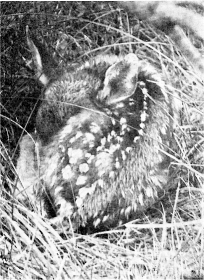
|
However, this represents a small minority of the total fawn population as less than ten such cases have been recorded in Yosemite Nature Notes during its twenty years of publication.
Although essentially nocturnal by nature, some of the bears in Yosemite are active throughout the day. As one visitor expressed. it, “With the arrival of the summer visitors, your bears apparently go on a 24-hour shift.”
During the warmer parts of the day, the majority of bears will bed down in a litter of pine needles in some secluded spot from which they can quietly slip away if disturbed. Other beds are simply scratched out hollows less than a foot deep.
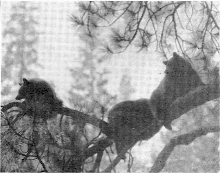
|
Some writers have referred to the black bear as the “playboy of the woods,” and anyone watching their actions over a period of time will have ample opportunity to understand why. They love to wrestle and play, and even their wanderings in search for food will result in amazing situations.
Bears habitually follow a given route, stepping each time in the footsteps previously made. Several such trails have been found in Yosemite where they have stepped in the same tracks as their predecessors, until a series of alternating depressions have developed nearly 6 inches in depth. One of these trails may be found in the wooded area between Camp Curry and Happy Isles.
Other signs left by bears beside footprints, consist of bear wallows, rotten logs and stumps ripped apart by bears in their search for insects, turned-over rocks, feces, and bear trees.
These bear trees are of particular interest to the park visitors, particularly, when the trees happen to be Quaking Aspen, for they permanently record the marks left by the bears. Incense Cedars, Ponderosa Pines and occasionally Lodgepole Pines are also used as “bear sign posts.” Arriving at such a tree, the bear usually stops and, standing erect on its hind legs, reaches up as high as possible, biting and scratching the tree. The reason for this action is not definitely known, although many writers have suggested that it may be some type of “social register.”
The black bear, being the largest mammal in the park, has practically no natural enemies. The largest bear is generally the boss of his domain until a still larger one comes along to replace him. Females with cubs will sometimes stand against a larger bear, but as a rule the smaller bear gives ground without engaging in any serious battle. Probably of all the mammals, the bear has the greatest respect for the skunk. On many occasions, our naturalists have observed skunks repeatedly refuse to be outbluffed by a bear (see Yosemite Nature Notes). Generally, the bear gives away after a few half-hearted attempts to frighten away the skunk, and allows the skunk to take over the remains of its unfinished meal. Very rarely the bear goes so far in its bluffing as to learn first hand what a formidable weapon the skunk possesses. It would be interesting to know whether the obvious caution exercised by bears toward skunks is in spired by actual experience of the skunk’s scent, or by some inner sense of caution acquired from the mother in early cubhood.
Next: Bear Policy • Contents • Previous: California Grizzly
| Online Library: | Title | Author | California | Geology | History | Indians | Muir | Mountaineering | Nature | Management |
http://www.yosemite.ca.us/library/bears/black_bear.html